Coalbed Methane Enrichment Regularity and Model in the Xishanyao Formation in the Santanghu Basin, NW China
Abstract
:1. Introduction
2. Geologic Settings
3. Methods and Data Sources
4. Coal Seam Characteristics and CBM Distribution
4.1. Coal Seam Distribution
4.2. Coal Proximate Analysis and Coal Petrology
4.3. Coal Reservoir Characteristics
4.4. Distribution of the CBM Content
5. CBM Accumulation
5.1. Coal Depositional Conditions
5.2. Influence of the Sedimentary Successions on CBM Preservation
5.3. Burial History
5.4. Genetic Analysis of CBM
5.5. Hydrological Factors
6. CBM Enrichment Models
6.1. CBM Enrichment in Slope Zone
6.2. CBM Enrichment by Fault-Hydraulic Plugging
7. Conclusions
- (1)
- The CBM geological conditions in the Santanghu Basin are characterized by a greater total coal seam thickness (10.5–61.3 m) and various coal burial depths (500−2600 m). The coal accumulation center is located in the Tiaohu Sag and Malang Sag, and the deepest burial depth is also located in these two sags. The Ro is generally 0.38%–0.62%, mainly composed of lignite and long flame coal, and the macerals are mainly composed of vitrinite (30%–90%), with certain amounts of inertinite (8.0%–64%).
- (2)
- The areas of high CBM content correspond to the regional coal accumulation centers, which are located in the Tiaohu and Malang Sags. These sags are favorable blocks for the CBM exploration in the Santanghu Basin, with a CBM content of up to 7.17 m3/t. Stable isotopic analysis shows that the CBM is of mixed origin, mainly thermogenic and secondarily biogenic.
- (3)
- Combining the depositional environments, structure features, and hydrogeological conditions, two types of CBM enrichment models are summarized, including the CBM enrichment in the slope break zone and the CBM enrichment by fault-hydraulic plugging in the reservoir. It is further delineated that the northern slope zone of the Tiaohu and Malang Sags are the sweet spots for the CBM exploration.
Supplementary Materials
Author Contributions
Funding
Data Availability Statement
Conflicts of Interest
References
- Huang, W.; Li, X.; Li, L.; Yu, F.; Wang, R.; Chen, X.; Miao, D. Prospect analysis of coalbed methane resources exploration in the Santanghu Basin. Nat. Gas Geosci. 2011, 22, 733–737. [Google Scholar]
- Wang, R. Analysis of coalbed methane exploration potential and evaluation of favorable blocks in Santanghu Basin. China Pet. Chem. Stand. Qual. 2014, 34, 199. [Google Scholar]
- Moore, T.A. Coalbed methane: A review. Int. J. Coal Geol. 2012, 101, 36–81. [Google Scholar] [CrossRef]
- Zhang, D.; Zhu, J.; Zhao, X.; Gao, Y.; Geng, M.; Chen, G.; Jiao, J.; Liu, S. Dynamic assessment of coalbed methane resources and availability in China. J. China Coal Soc. 2018, 43, 1598–1604. [Google Scholar] [CrossRef]
- Geng, M.; Chen, H.; Chen, Y.; Zeng, L.; Chen, S.; Jiang, X. Methods and results of the fourth round national CBM resources evaluation. Coal Sci. Technol. 2018, 46, 64–68. [Google Scholar] [CrossRef]
- Qin, Y.; Shen, J.; Shi, R. Strategic value and choice on construction of large CMG industry in China. J. China Coal Soc. 2022, 47, 371–387. [Google Scholar] [CrossRef]
- Sang, S.; Wang, R.; Zhou, X.; Huang, H.; Liu, S.; Han, S. Review on carbon neutralization associated with coal geology. Coal Geol. Explor. 2021, 49, 2. [Google Scholar]
- Li, Y.; Pan, S.; Ning, S.; Shao, L.; Jing, Z.; Wang, Z. Coal measure metallogeny: Metallogenic system and implication for resource and environment. Sci. China (Earth Sci.) 2022, 65, 1211–1228. [Google Scholar] [CrossRef]
- Chen, Y.; Tang, D.; Xu, H.; Li, Y.; Meng, Y. Structural controls on coalbed methane accumulation and high production models in the eastern margin of Ordos Basin, China. J. Nat. Gas Sci. Eng. 2015, 23, 524–537. [Google Scholar] [CrossRef]
- Shen, J.; Li, K.; Zhang, H.; Shabbiri, K.; Hu, Q.; Zhang, C. The geochemical characteristics, origin, migration and accumulation modes of deep coal-measure gas in the west of Linxing block at the eastern margin of Ordos Basin. J. Nat. Gas Sci. Eng. 2021, 91, 103965. [Google Scholar] [CrossRef]
- Yong, L.; Yang, J.; Pan, Z.; Meng, S.; Wang, K.; Niu, X. Unconventional Natural Gas Accumulations in Stacked Deposits: A Discussion of Upper Paleozoic Coal-Bearing Strata in the East Margin of the Ordos Basin, China. Acta Geol. Sin.—Engl. Ed. 2019, 93, 111–129. [Google Scholar]
- Hou, Y.; Liu, D.; Zhao, F.; Zhong, L.; Emmanuel, N.N.; Zhang, Q. Geological Characteristics Affecting Coalbed Methane: A Case Study in the Anze Area, Southern Qinshui Basin. Nat. Resour. Res. 2022, 31, 1425–1442. [Google Scholar] [CrossRef]
- Liang, X.; Shan, C.; Li, Z.; Luo, Y. Exploration innovation practice and effective exploitation key technology of mountain coalbed methane—Taking the Junlian coalbed methane field in southern Sichuan Basin as an example. Nat. Gas Ind. 2022, 42, 107–129. [Google Scholar]
- Wang, B.; Qin, Y.; Shen, J.; Wang, G. Summarization of geological study on low rank coalbed methane in China. Coal Sci. Technol. 2017, 45, 170–179. [Google Scholar] [CrossRef]
- Li, Y.; Xu, L.; Zhang, S.; Wu, J.; Bi, J.; Meng, S.; Tao, C. Gas bearing system difference in deep coal seams and corresponded development strategy. J. China Coal Soc. 2023, 48, 900–917. [Google Scholar] [CrossRef]
- Wu, Y.; Wang, G.; Wang, Q. Difficulties and development direction of medium and low-rank coalbed methane industry in Xinjiang region. China Coalbed Methane 2023, 20, 3–5+20. [Google Scholar]
- Li, W.; Tian, W.; Sun, B.; Wang, X.; Zhao, Y. Characteristics of low-stage coalbed methane formation, exploration and development technology. Nat. Gas Ind. 2008, 23–24+29+135. [Google Scholar]
- Sun, P.; Wang, B.; Sun, F.; Zheng, G.; Li, G.; Wang, H.; Liu, H.; Deng, Z. Study on the formation mode of low-stage coalbed methane in China. J. Pet. 2009, 30, 648–653. [Google Scholar]
- Wang, T.; Shao, L. Formation Conditions and Resource Evaluation of Jurassic Coal in Northwest China; Geological Press: Beijing, China, 2013; pp. 143–148. [Google Scholar]
- Xu, F.; Hou, W.; Xiong, X.; Xu, B.; Wu, P.; Wang, H.; Feng, K.; Yun, J.; Li, S.; Zhang, L.; et al. The status and development strategy of coalbed methane industry in China. Pet. Explor. Dev. 2023, 50, 669–682. [Google Scholar] [CrossRef]
- Huangfu, Y. Characterization of coalbed methane formation in the low coal rank of the Tuha-Santanghu Basin. Geol. Rev. 2019, 65, 153–154. [Google Scholar] [CrossRef]
- Liang, H.; Li, X.; Chang, Y. CBM enrichment regularity and development potential evaluation in Tiaohu-Malang Sag. China Coalbed Methane 2016, 13, 13–17. [Google Scholar]
- Allégre, C.J.; Courtillot, V.; Tapponnier, P.; Hirn, A.; Mattauer, M.; Coulon, C.; Jaeger, J.J.; Achache, J.; Schärer, U.; Marcoux, J.; et al. Structure and evolution of the Himalaya–Tibet orogenic belt. Nature 1984, 307, 17–22. [Google Scholar] [CrossRef]
- Hendrix, M.S.; Graham, S.A.; Carroll, A.R.; Sobel, E.R.; Mcknight, C.L.; Schulein, B.J.; Wang, Z. Sedimentary record and climatic implications of recurrent deformation in the Tian Shan: Evidence from Mesozoic strata of the north Tarim, south Junggar, and Turpan basins, northwest China. GSA Bull. 1992, 104, 53–79. [Google Scholar] [CrossRef]
- Li, D. Hydrocarbon occurrences in the petroliferous basins of western China. Mar. Pet. Geol. 1995, 12, 26–34. [Google Scholar] [CrossRef]
- Zhao, Z.; Guo, Z.; Zhang, C.; Lu, J. Tectonic evolution and petroleum geological significance of the Santanghu Basin, eastern Xinjiang. J. Peking Univ. (Nat. Sci. Ed.) 2003, 2, 219–228. [Google Scholar] [CrossRef]
- Zhu, B.; Feng, J.; Hu, B.; Wei, X. Recognition of the basement of the Santanghu Basin. Xinjiang Pet. Geol. 1997, 3, 197–200+191. [Google Scholar]
- Liu, S.; Ma, X.; Zhou, J.; Zhang, J.; Fan, L. Delineation of coal-endowed tectonic units and tectonic features in the Santanghu Basin, Xinjiang. Geol. Rev. 2017, 63, 271–272. [Google Scholar] [CrossRef]
- Standardization Administration of the People’s Republic of China. Classification of Macrolithotype for Bituminous Coal: GB/T 18023-2000; Standards Press of China: Beijing, China, 2000. [Google Scholar]
- International Committee for Coal and Organic Petrology (ICCP). The new vitrinite classification (ICCP System 1994). Fuel 1998, 77, 349–358. [Google Scholar] [CrossRef]
- Pickel, W.; Kus, J.; Flores, D.; Kalaitzidis, S.; Christanis, K.; Cardott, B.J.; Misz-Kennan, M.; Rodrigues, S.; Hentschel, A.; Hamor-Vido, M.; et al. Classification of liptinite—ICCP System 1994. Int. J. Coal Geol. 2017, 169, 40–61. [Google Scholar] [CrossRef]
- International Committee for Coal and Organic Petrology (ICCP). The new inertinite classification (ICCP System 1994). Fuel 2001, 80, 459–471. [Google Scholar] [CrossRef]
- Standardization Administration of the People’s Republic of China. Proximate Analysis of Coal by Instrumental Method: GB/T 30732-2014; Standards Press of China: Beijing, China, 2014. [Google Scholar]
- Wang, T.; Tian, Y.; Shao, L.; Lu, J. Sequence-paleogeography and coal accumulation of the early and middle Jurassic in the Junggar Basin. J. China Coal Soc. 2013, 38, 114–121. [Google Scholar] [CrossRef]
- Bureau of Coal Industry of the People’s Republic of China. Classification for Volatile Matter of Coal: MT/T 849-2000; Standards Press of China: Beijing, China, 2000. [Google Scholar]
- Bureau of Coal Industry of the People’s Republic of China. Classification for Total Moisture in Coal: MT/T 850-2000; Standards Press of China: Beijing, China, 2000. [Google Scholar]
- Standardization Administration of the People’s Republic of China. Classification for Quality of Coal—Part 1: Ash: GB/T 15224.1-2018; Standards Press of China: Beijing, China, 2018. [Google Scholar]
- Groshong, R.H.; Pashin, J.C.; Mclntyre, M.R. Structural controls on fractured coal reservoirs in the southern Appalachian Black Warrior foreland basin. J. Struct. Geol. 2009, 31, 874–886. [Google Scholar] [CrossRef]
- Hou, Q.; Li, H.; Fan, J.; Ju, Y.; Wang, T.; Li, X.; Wu, Y. Structure and coalbed methane occurrence in tectonically deformed coals. Sci. China Earth Sci. 2012, 55, 1755–1763. [Google Scholar] [CrossRef]
- Wang, H.; Yao, Y.; Liu, D.; Cai, Y.; Yang, Y.; Zhou, S. Determination of the degree of coal deformation and its effects on gas production in the southern Qinshui Basin, North China. J. Pet. Sci. Eng. 2022, 216, 110746. [Google Scholar] [CrossRef]
- Cao, Z.; Lin, B.; Liu, T. The impact of depositional environment and tectonic evolution on coalbed methane occurrence in West Henan, China. Int. J. Min. Sci. Technol. 2019, 29, 297–305. [Google Scholar] [CrossRef]
- Li, H.Y.; Ogawa, Y.; Shimada, S. Mechanism of methane flow through sheared coals and its role on methane recovery. Fuel 2003, 82, 1271–1279. [Google Scholar] [CrossRef]
- Meng, Z.; Tain, Y.; Li, G. Relationship and control mechanism between permeability and geostress in coal reservoirs in the southern Qinshui Basin. Prog. Nat. Sci. 2009, 19, 1142–1148. [Google Scholar]
- Kang, Y.; Sun, L.; Zhang, B.; Gu, J.; Mao, D. Discussion on classification of coalbed reservoir permeability in China. J. China Coal Soc. 2017, 42, 186–194. [Google Scholar] [CrossRef]
- Wu, B.; Zhou, L.; Pan, X.; Zhang, Y.; Du, S. Exploration on the genesis of low-stage coalbed methane in the Santanghu Basin, Xinjiang. Spec. Reserv. 2020, 27, 47–54. [Google Scholar]
- Kuang, L.; Wen, S.; Li, S.; Fan, T.; Tian, W.; Wang, X.; Qi, L.; Ying, Y.; Mao, D.; Li, X. Accumulation mechanism and exploration breakthrough of low-rank CBM in the Tuha-Santanghu Basin. Nat. Gas Ind. 2022, 42, 33–42. [Google Scholar]
- Fu, H.; Tang, D.; Xu, T.; Xu, H.; Tao, S.; Zhao, J.; Chen, B.; Yin, Z. Preliminary research on CBM enrichment models of low-rank coal and its geological controls: A case study in the middle of the southern Junggar Basin, NW China. Mar. Pet. Geol. 2017, 83, 97–110. [Google Scholar] [CrossRef]
- Teichmüller, M. The genesis of coal from the viewpoint of coal petrology. Int. J. Coal Geol. 1989, 12, 1–87. [Google Scholar] [CrossRef]
- Shao, L.; Wang, X.; Wang, D.; Li, M.; Wang, S.; Li, Y.; Shao, K.; Zhang, C.; Gao, C.; Dong, D.; et al. Sequence stratigraphy, paleogeography, and coal accumulation regularity of major coal-accumulating periods in China. Int. J. Coal Sci. Technol. 2020, 7, 240–262. [Google Scholar] [CrossRef]
- Shen, Y.; Qin, Y.; Guo, Y.; Ren, H.; Wei, Z.; Xie, G. The Upper Permian Coalbed Methane Bearing System and its Sedimentary Control in Western Guizhou, China. Geol. J. China Univ. 2012, 18, 427–432. [Google Scholar] [CrossRef]
- Sun, B.; Shao, Y.; Gao, Z.; Li, J.; Sun, B.; Yang, M.; Zhou, J.; Yao, H.; Sun, F.; Shao, L. Coalbed Methane Enrichment Characteristics and Exploration Target Selection in the Zhuozishan Coalfield of the Western Ordos Basin, China. ACS Omega 2022, 7, 43531–43547. [Google Scholar] [CrossRef]
- Zhao, L.; Qin, Y.; Cai, C.; Xie, Y.; Wang, G.; Huang, B.; Xu, C. Control of coal facies to adsorption-desorption divergence of coals: A case from the Xiqu Drainage Area, Gujiao CBM Block, North China. Int. J. Coal Geol. 2017, 171, 169–184. [Google Scholar] [CrossRef]
- Scott, S.; Anderson, B.; Crosdale, P.; Dingwall, J.; Leblang, G. Coal petrology and coal seam gas contents of the Walloon Subgroup Surat Basin, Queensland, Australia. Int. J. Coal Geol. 2007, 70, 209–222. [Google Scholar] [CrossRef]
- Xu, H.; Tang, D. Research progress of control mechanism of coal petrology on CBM production. Coal Sci. Technol. 2016, 44, 140–145+158. [Google Scholar] [CrossRef]
- Yao, Y.; Liu, D.; Tang, S.; Huang, W. Influence and Control of Coal Petrological Composition on theDevelopment of Microfracture of Coal Reservoir in the Qinshui Basin. J. China Univ. Min. Technol. 2010, 39, 6–13. [Google Scholar]
- Chen, G.; Qin, Y.; Hu, Z.; Li, W. Characteristics of reservoir assemblage of deep CBM-bearing system in Baijiahai dome of Junggar Basin. J. China Coal Soc. 2016, 41, 80–86. [Google Scholar] [CrossRef]
- Feng, S. Sedimentary Evolution and Coal Accumulation of the Lower and the Middle Jurassic in SanTangHu Basin. Master’s Thesis, Xinjiang University, Ürümqi, China, 2015. [Google Scholar]
- Li, Z.; Li, X.; Liang, H.; Wang, R. Influence of hydrogeologic conditions on low coal rank coalbed methane in Tuha and Santanghu basins. Xinjiang Pet. Geol. 2013, 34, 158–161. [Google Scholar]
- Liu, H.; Liu, C.; Wang, H.; Yang, Y.; Li, J. Simulation of biogenic coalbed methane formation in low rank coal in Northwest China. Xinjiang Geol. 2006, 02, 149–152. [Google Scholar]
- Qin, Y. Progress and review of research on coalbed methane formation in China. J. Coll. Geol. 2012, 18, 405–418. [Google Scholar] [CrossRef]
- Rice, C.A.; Flores, R.M.; Stricker, G.D.; Ellis, M.S. Chemical and stable isotopic evidence for water/rock interaction and biogenic origin of coalbed methane, Fort Union Formation, Powder River Basin, Wyoming and Montana USA. Int. J. Coal Geol. 2008, 76, 76–85. [Google Scholar] [CrossRef]
- Kotarba, M.J.; Rice, D.D. Composition and origin of coalbed gases in the Lower Silesian basin, southwest Poland. Appl. Geochem. 2001, 16, 895–910. [Google Scholar] [CrossRef]
- Zhang, X.; Tao, M.; Wang, W.; Duan, Y.; Shi, B. Generation of biogenic coalbed methane and its resource significance. Miner. Rock Geochem. Bull. 2004, 23, 166–171. [Google Scholar]
- Song, Y.; Liu, S.; Zhang, Q.; Tao, M.; Zhao, M.; Hong, F. Coalbed methane genesis, occurrence and accumulation in China. Pet. Sci. 2012, 9, 269–280. [Google Scholar] [CrossRef]
- Kinnon, E.C.P.; Golding, S.D.; Boreham, C.J.; Baublys, K.A.; Esterle, J.S. Stable isotope and water quality analysis of coal bed methane production waters and gases from the Bowen Basin, Australia. Int. J. Coal Geol. 2010, 82, 219–231. [Google Scholar] [CrossRef]
- Hamilton, S.K.; Golding, S.D.; Baublys, K.A.; Esterle, J.S. Stable isotopic and molecular composition of desorbed coal seam gases from the Walloon Subgroup, eastern Surat Basin, Australia. Int. J. Coal Geol. 2014, 122, 21–36. [Google Scholar] [CrossRef]
- Tao, J.; Shen, J.; Wang, J.; Li, Y.; Li, C. Genetic Types and Exploration Prospect of Coalbed Methane in Jiergalangtu Depression, Erlian Basin. Geol. J. China Univ. 2019, 25, 295–301. [Google Scholar] [CrossRef]
- Lamarre, R.A. Hydrodynamic and stratigraphic controls for a large coalbed methane accumulation in Ferron coals of east-central Utah. Int. J. Coal Geol. 2003, 56, 97–110. [Google Scholar] [CrossRef]
- Scott, A.R. Hydrogeologic factors affecting gas content distribution in coal beds. Int. J. Coal Geol. 2002, 50, 363–387. [Google Scholar] [CrossRef]
- Wang, Q.; Yang, S.; Wang, G.; Xu, H.; Ren, P.; Dong, W. Delineation of methane weathering zones in the Middle-Lower Jurassic coal beds of the Santanghu Basin. Xinjiang Pet. Geol. 2020, 41, 261–268. [Google Scholar]
- Solano-Acosta, W.; Schimmelmann, A.; Mastalerz, M.; Arango, I. Diagenetic mineralization in Pennsylvanian coals from Indiana, USA: 13C/12C and 18O/16O implications for cleat origin and coalbed methane generation. Int. J. Coal Geol. 2008, 73, 219–236. [Google Scholar] [CrossRef]
- Lei, H.; Sun, Q.; Sun, B.; Li, W.; Chen, G.; Tian, W. Conditions and main controlling factors of low-stage coalbed methane formation in Holinhe area, Erlian Basin. Nat. Gas Ind. 2010, 30, 26–30+123–124. [Google Scholar]

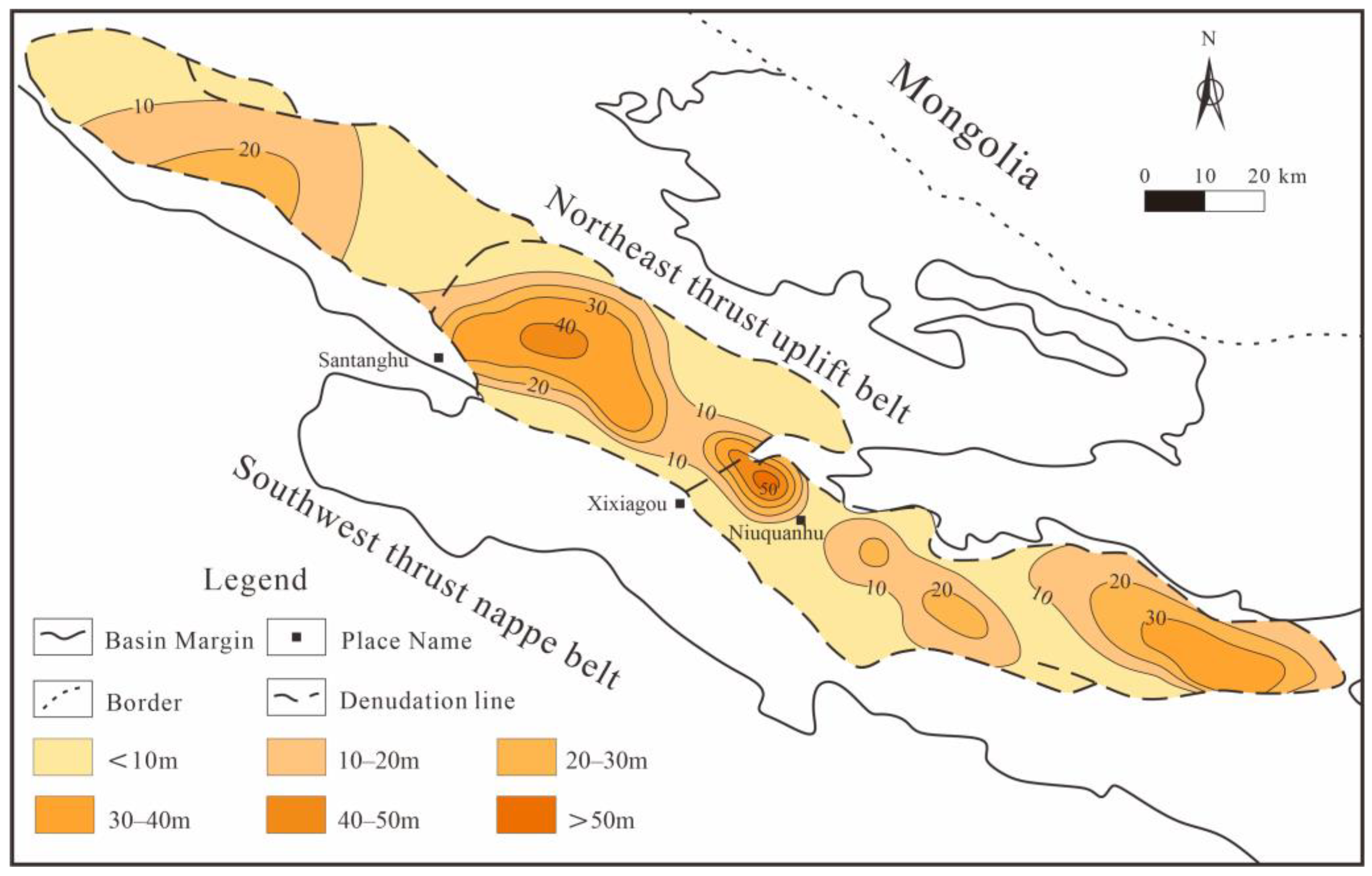
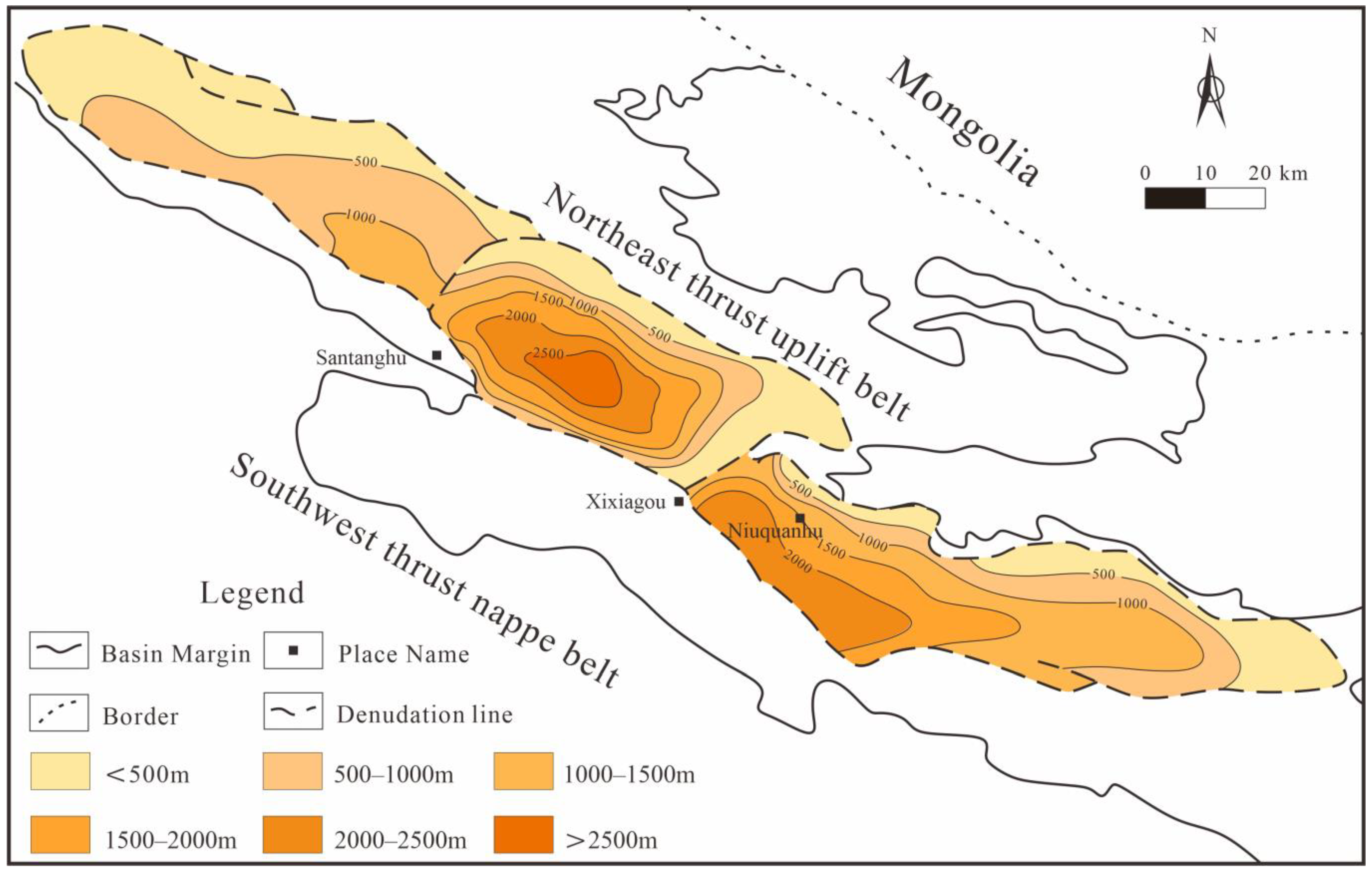

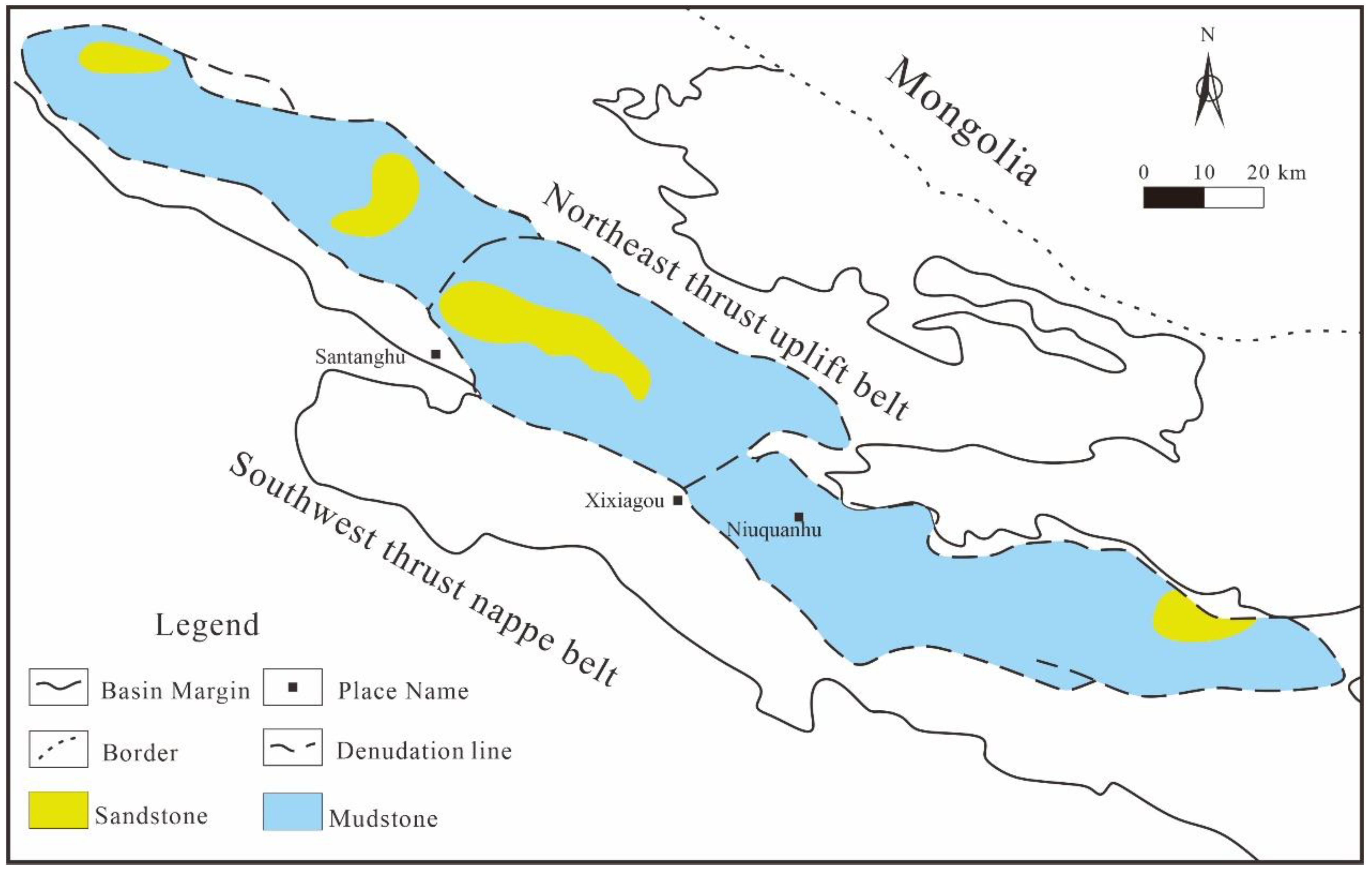
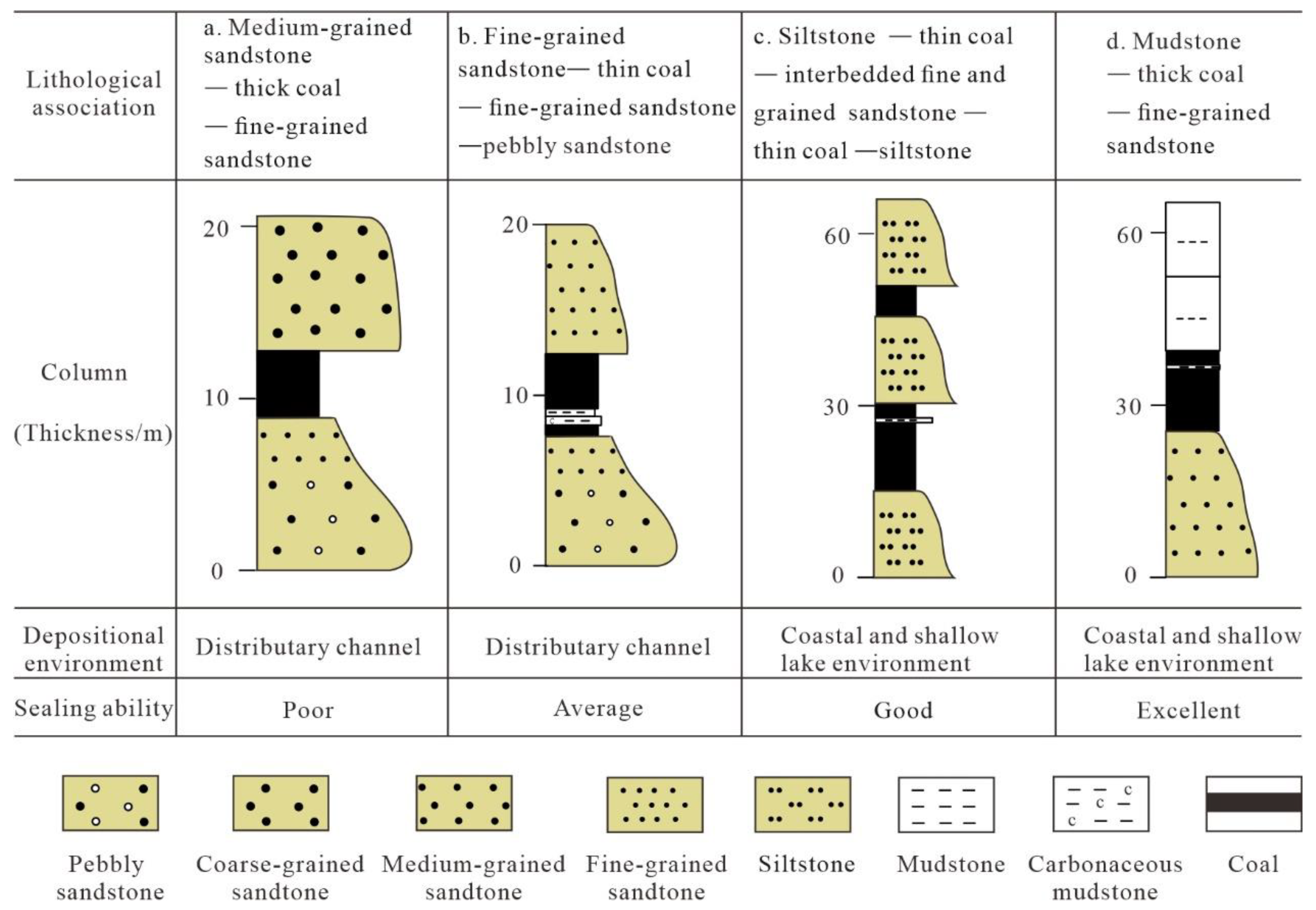

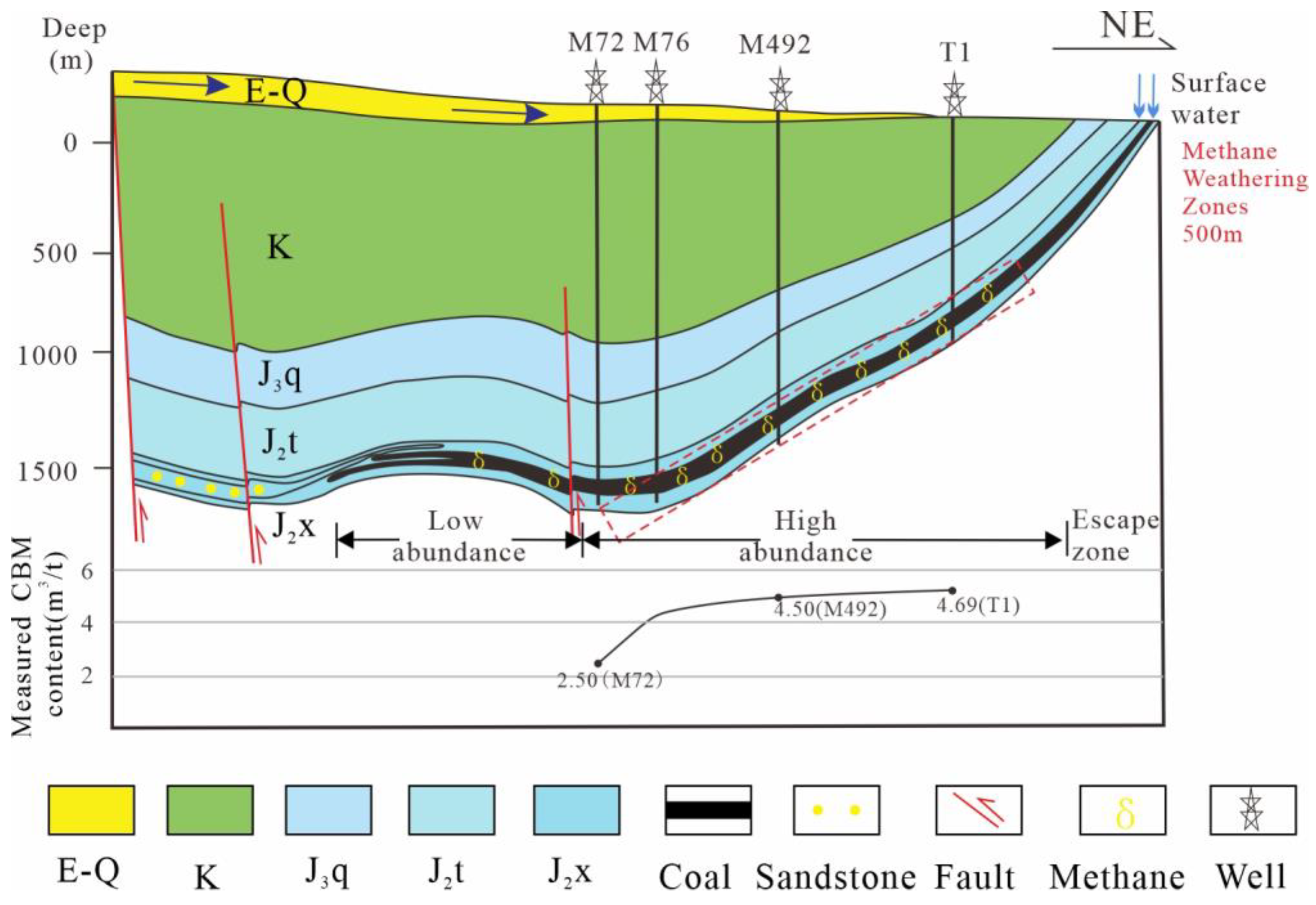
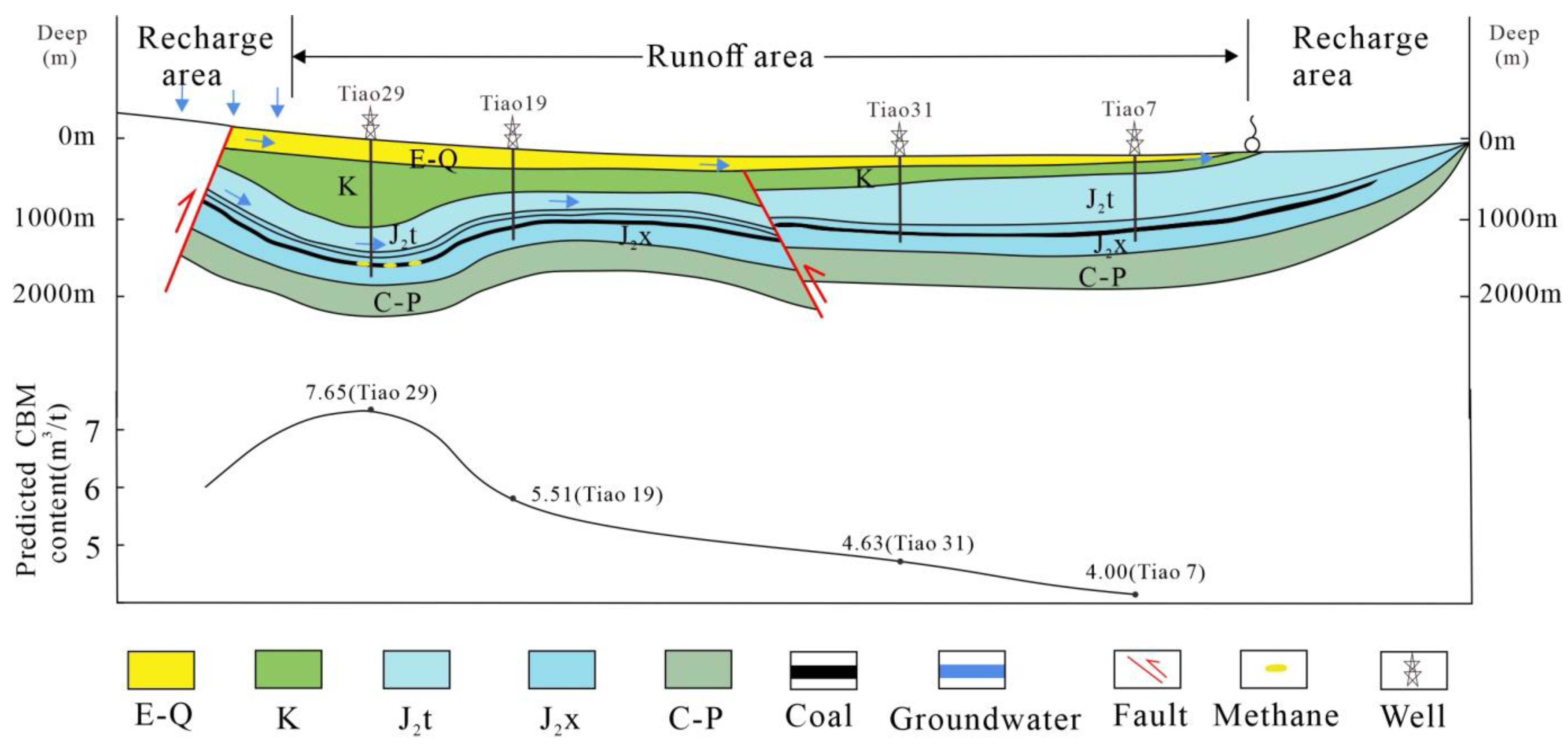
| System | Series | Group/Formation | Contact |
|---|---|---|---|
| Cretaceous | Lower | Tulufan (K1tg) | unconformity |
| Jurassic | Upper | Kalazha (J3k) | |
| Qigu (J3q) | conformity | ||
| Middle | Toutunhe (J2t) | conformity | |
| Xishanyao (J2x) | conformity | ||
| Lower | Sangonghe (J1s) | conformity | |
| Badaowan (J1b) | unconformity | ||
| Triassic | Upper | Haojiagou (T3h) |
| Well ID | Burial Depth (m) | Coal Macrolitho-Type | Maceral Compositions (%) | Ro (%) | ||
|---|---|---|---|---|---|---|
| Vitrinite | Inertinite | Liptinite | ||||
| Tangqican1 | 722.4–757.06 | semi-dull | 48.7 | 48.4 | 2.9 | 0.61 |
| Tang1 | 992.31–1027.13 | semi-bright | 36.1 | 61.8 | 2.1 | 0.45 |
| Tang3 | 1186.3 | semi-dull | 90.0 | 8.0 | 2.0 | 0.57 |
| Bei2 | 1966.2 | semi-dull | 30.0 | 64.0 | 6.0 | 0.61 |
| Ma205 | 768.85–768.88 | bright | 46.0 | 44.0 | 10.0 | 0.38 |
| Ma76 | 1800.4 | semi-bright | 60.0 | 34.0 | 6.0 | 0.62 |
| Tiao15 | 843.72–851.93 | semi-dull | 44.9 | 53.8 | 1.3 | 0.44 |
| Well ID | Depth (m) | Proximate Analysis (%) | Data Points | |||
|---|---|---|---|---|---|---|
| Mad | Ad | Vdaf | FCad | |||
| Tangqican1 | 722.29–757.38 | 8.32 | 11.92 | 38.01 | 50.21 | 46 |
| Tang1 | 991.57–1027.13 | 4.23 | 2.94 | 31.42 | 62.50 | 11 |
| Tang3 | 1186.3 | 6.94 | 2.58 | 45.11 | 49.76 | 1 |
| Ma205 | 768.77–768.79 | 7.73 | 3.1 | 46.19 | 48.12 | 1 |
| Ma76 | 1800.4–1806.54 | 3.00 | 30.24 | 21.73 | 51.80 | 2 |
| Tiao15 | 843.72–851.93 | 8.13 | 5.28 | 32.21 | 59.31 | 17 |
| Structural Units | Mineralization (mg/L) | Water Chemical Type | Hydrogeological Type | Data Source |
|---|---|---|---|---|
| Kumusu Sag | 1800–3400 | Na-Cl-SO4 | confined weak runoff | [70] |
| Hanshuiquan Sag | 1400–3100 | Na-Cl-SO4 | confined weak runoff | [70] |
| Tiaohu Sag | 2400–5000 | Na-Cl-SO4 | open local stagnation | [70] |
| Malang Sag | 1000–5000 | Na-HCO3-SO4 | open local stagnation | [70] |
| Naomaohu Sag | 1000–3000 | Na-Cl-SO4 | confined weak runoff | [70] |
| Ma 18 | 3882 | HCO3-Na | ||
| Ma 206 | 5625–5657 | Na2SO4 | ||
| Ma 214 | 3827 | NaHCO3 | ||
| Ma 208 | 3880 | NaHCO3 | ||
| Ma 209 | 3155 | NaHCO3 | ||
| Ma 203 | 1160 | Na2SO4 | ||
| Ma 205 | 4778 | NaHCO3 | ||
| Ma 202 | 2241 | Na2SO4 | ||
| Ma 201 | 2382 | NaHCO3 | ||
| Xi 9–13 | 2398 | NaHCO3 | ||
| Xi 9–11 | 2865 | NaHCO3 |
Disclaimer/Publisher’s Note: The statements, opinions and data contained in all publications are solely those of the individual author(s) and contributor(s) and not of MDPI and/or the editor(s). MDPI and/or the editor(s) disclaim responsibility for any injury to people or property resulting from any ideas, methods, instructions or products referred to in the content. |
© 2023 by the authors. Licensee MDPI, Basel, Switzerland. This article is an open access article distributed under the terms and conditions of the Creative Commons Attribution (CC BY) license (https://creativecommons.org/licenses/by/4.0/).
Share and Cite
Li, X.; Zhou, J.; Jiao, L.; Sun, B.; Huang, Y.; Huang, D.; Zhang, J.; Shao, L. Coalbed Methane Enrichment Regularity and Model in the Xishanyao Formation in the Santanghu Basin, NW China. Minerals 2023, 13, 1369. https://doi.org/10.3390/min13111369
Li X, Zhou J, Jiao L, Sun B, Huang Y, Huang D, Zhang J, Shao L. Coalbed Methane Enrichment Regularity and Model in the Xishanyao Formation in the Santanghu Basin, NW China. Minerals. 2023; 13(11):1369. https://doi.org/10.3390/min13111369
Chicago/Turabian StyleLi, Xinning, Jiamin Zhou, Lixin Jiao, Bin Sun, Yangyang Huang, Diefang Huang, Junlang Zhang, and Longyi Shao. 2023. "Coalbed Methane Enrichment Regularity and Model in the Xishanyao Formation in the Santanghu Basin, NW China" Minerals 13, no. 11: 1369. https://doi.org/10.3390/min13111369





